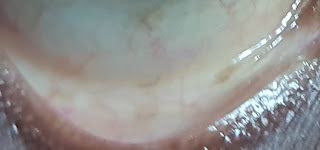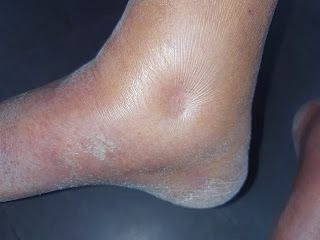1801006175 CASE PRESENTATION
long case
- pain abdomen since 6 days
- nausea and vomiting since 6 days
- abdominal distention since 5 days
Pulmonary Area - First and Second Heart Sounds Heard, No other sounds are heard
Aortic Area - First and Second Heart Sounds Heard, No other sounds are heard
Inspection -
Supra clavicular: resonant resonant
Infra clavicular: resonant resonant
Mammary: resonant Resonant
Axillary: resonant resonant
Infra axillary: resonant resonant
Supra scapular: resonant resonant
Infra scapular: resonant resonant
Inter scapular: resonant resonant
Supra clavicular:. NVBS NVBS
Infra clavicular: NVBS NVBS
Mammary: NVBS NVBS
Axillary: NVBS NVBS
Infra axillary: NVBS NVBS
Supra scapular: NVBS NVBS
Infra scapular: NVBS NVBS
Inter scapular: NVBS NVBS
In lft there is elevation of bilirubin , total protein .
Chief complaints:
A 45 old male patient auto driver by occupation came to the OPD with cheif complaints of swelling in both the legs & shortness of breath since 10 days.
History of present illness:
Patient was apparently asymptomatic 10 days back then he developed increased swelling in both lower limbs which is pitting type of edema .insidious in onset gradual in progression. Swelling is up to the ankles . It is not seen above the ankles .
patient also complains of shortness of breath which is insidious onset gradually progressive . It progressed from grade 2 to grade-4(ie patient first had dyspnoea on normal physical activity but then later he had dyspnoea even on rest) Patient also complains of breathlessness in lying down position. Aggravated on activity and relived on rest .
History of paroxysmal nocturnal Dyspnea is present 3 hours after patient sleeps and it is relieved when patient arises.
Patient also complains of fatigue on activity.
No complaints of facial puffiness .
No H/o chest pain , palpitations, syncope attack .
No complaints of confusion , altered mental status , lack of concentration , memory impairment .
No complaints of abdominal pain .
No H/O cough , sputum , hemoptysis, chest pain.
No H/O burning micturation , increased frequency of urine , decreased urine output .
Past history:
Patient is known case of diabetic since 6 years .Patient is also hypertensive since 5 years . No history of tuberculosis, asthma , epilepsy .
Treatment history:
patient is taking insulin injections for the diabetes and for hypertension he is taking Tab Tab metaprolol .
Personal history:
Appetite is normal
diet is mixed
bowel and bladder are regular
sleep is adequate
no addictions & no allergies.
Family history:
no similar complaints in the family.
General examination:
Patient is conscious,coherent & cooperative. Moderately built and well nourished , well oriented with time , place and person.
Pallor is present
No icterus , cyanosis , clubbing , lymphadenopathy.
Pedal edema is present.
Vitals:
Temperature:98.6°f
Pulse rate:82b/m
Blood pressure:130/80mmhg.
Respiratory rate:21 cycles/min.
Systemic examination:
CVS Examination:
Inspection:
JVP is raised. (Normal range is 6 to 8 cm of h2o)10 cm of h2o
Chest wall is bilaterally symmetrical. No precordial bulge, no engorged veins over the chest wall , no engorged neck veins , tracheal position is central . No scars and sinuses .
Palpation :
Apex beat is present at the 7 th intercostal space 1cm lateral to the mid clavicular line .
No pulsations, No parastetnal heave , No precordial or carotid thrill , No dilated veins .
Percussion : normal
Auscultation: s1and s2 are heard and no murmurs.
Respiratory system examination:
Inspection:
Upper respiratory tract : oral cavity , nose , pharynx are normal.
Lower respiratory tract :
Chest is bilaterally symmetrical , No chest deformities, No spinal deformities, Movements of the chest are symmetrical.
Palpation :
Apex beat at the level of 8th intercostal space 1cm lateral to the midclavicular line .
Trachea is central in position, Chest expansion is normal , expansion of chest is bilaterally symmetrical. No tactile Fremitus and No friction fremitus. Vocal fremitus is also normal.
Percussion : resonant.
Auscultation:
Rales are heard
Bilateral crepitations present
Vocal resonance is normal , No wheezing , No stridor , No pleural and pericordial rub .
Per abdomen examination:
Inspection:
Abdominal distension is absent .
Umbilicus is inverted(normal) , all quadrants move equally with the respiration, No visible pulsations , No scars , sinuses , striae , stretched skin, No hernial orifices , No veins on the abdominal wall .
Palpation :
No rise of temperature and No tenderness over the abdomen .
No enlargement of organs .
Percussion : shifting dullness is absent . No fluid thrill , No increase in the liver span .
Auscultation:
Bowel sounds are heard .
CNS examination :
Higher mental functions are normal .
Cranial nerves examination is normal .
Motor system :
1. Bulk : both right and left upper and lower limbs are normal .
2.Tone : tone of both upper and lower limbs are normal .
3. Power : power of neck muscles , upper limbs , lower limbs, trunk muscles are good .
4. Reflexes : superficial reflexes and deep reflexes are normal .
Deep tendon reflexes : Biceps jerk , triceps jerk , ankle jerk , knee jerk are present .
Normal gait and No involuntary movements.
Sensory system : crude touch , pain , temperature, fine touch , vibration , position sense are normal .
Cerebellar signs : Nystagmus , Dysarthria , Hypotonia are not present .
No signs of meningeal irritation.
Provisional diagnosis : Heart failure with pulmonary edema .
Investigations:
Hemogram:
Hb: 9.5gm/dl (nv: 13-17)
Mcv : 80.8fl (nv :83-101)
Mch: 26.5pg (nv :27-32)
RFT:
Urea : 40 mg/dl (12-42)
Creatinine : 1 mg/dl (0.9-1.3)
LFT:
Alkaline phosphate : 210IU/L (53-128)
Albumin :3.23gm/dl (3.5-5.2)
Serum iron: 60micrograms/dl .(nv is 60 to 120 mcg per l)
ECG :
Treatment:
Bed rest .
Fluid restriction <1.5 lit/day
Salt restriction < 2gm/day
Inj.Lasix 40mg IV/BD.(furosemide tablets)
Monitor vitals.





















Comments
Post a Comment